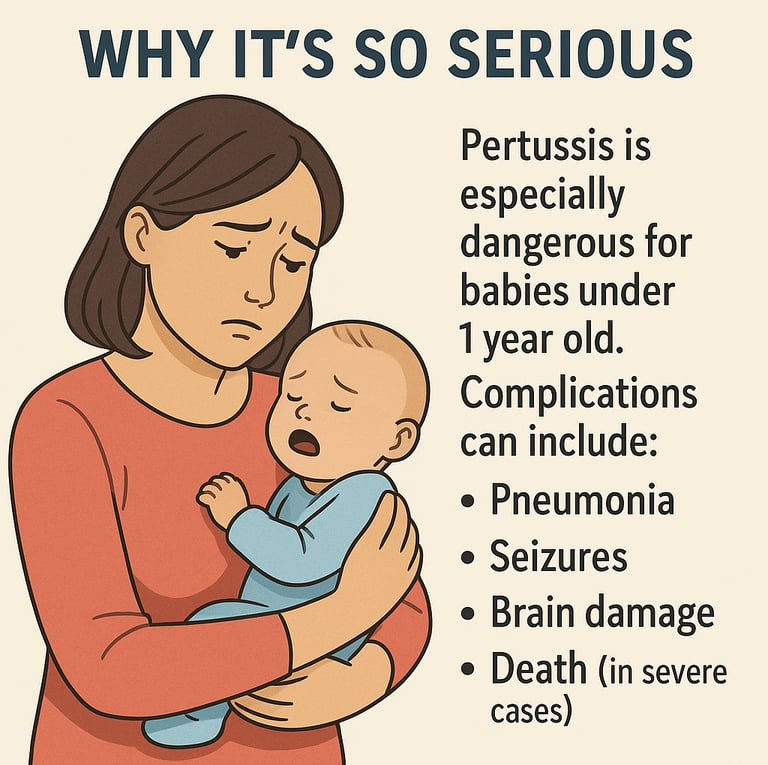Stay updated on what is trending in health. Discover tips and resources for a healthier, balanced life.
Pertussis (Whooping Cough): What You Need to Know
Learn what pertussis (whooping cough) is, how it spreads, symptoms, dangers, and treatment. Learn why it is so serious and how to prevent your family from this deadly disease.
DISEASES AND CONDITIONS
Dr. S. Ali
11/25/20254 min read


Pertussis, also known as whooping cough, is a highly contagious respiratory infection that can affect people of all ages—but it’s especially dangerous for babies. The name comes from the unmistakable “whoop” sound that some people make when gasping for air after a coughing fit.
Let’s break down what this infection is, how it spreads, and what you can do to protect yourself and your loved ones.
What Is Pertussis?
Pertussis is caused by a bacteria called Bordetella pertussis. It attacks the lining of the respiratory tract and produces toxins that cause inflammation and swelling. The result? Severe coughing spells that can make it hard to breathe, eat, or even sleep.
How Does It Spread?
Just like the common cold, pertussis spreads through droplets when an infected person coughs or sneezes. It’s incredibly contagious—if someone in your household has it, there’s a good chance others might catch it too.
What makes pertussis tricky is that symptoms often start out mild—like a cold—before turning serious.
Symptoms to Watch For
Pertussis doesn’t start off with a bang—it often begins like a mild cold, which makes it tricky to spot.
Early Stage (1–2 weeks):
These symptoms are mild and may not raise alarms:
Runny or stuffy nose
Mild cough
Low-grade fever
Occasional sneezing
Because it looks like the common cold, people often don’t realize they’re contagious.
Paroxysmal Stage (Weeks 2–6 or longer):
This is when classic “whooping cough” symptoms kick in:
Severe, rapid coughing fits that empty the lungs of air
A high-pitched “whoop” sound when inhaling after a coughing fit
Vomiting after coughing
Exhaustion and trouble catching your breath after the fits
These episodes can happen multiple times a day and are especially exhausting at night.
In Babies:
Infants may not cough at all. Instead, they might:
Stop breathing temporarily
Turn blue or struggle to breathe
Appear extremely tired or listless
Note: Pertussis in babies can be life-threatening. If you notice any of these signs, seek emergency care right away.
Why It’s So Serious
Pertussis is especially dangerous for babies under 1 year old because their immune systems are still developing, and they haven’t yet completed their full vaccination series. For these little ones, a bout of whooping cough can quickly turn severe and lead to serious complications. Some of the most concerning issues include:
Pneumonia: This lung infection is the most common complication of pertussis and can make it very hard for babies to breathe. Pneumonia often requires hospitalization and close medical care.
Seizures: The intense coughing spells can sometimes cause low oxygen levels or increased pressure in the brain, leading to seizures. These can be frightening and may require emergency treatment.
Brain Damage: In rare but severe cases, the lack of oxygen during coughing fits or prolonged seizures can cause lasting brain injury, affecting development and function.
Death: Sadly, pertussis can be fatal in infants, especially those too young to be fully vaccinated or with weakened health. This risk makes prevention and early treatment critical.
But it’s not just babies who suffer. Teens and adults can also face serious problems from pertussis, even though it often feels like a prolonged, severe cough at first. The forceful and repetitive coughing can cause:
Broken ribs: The violent spasms during coughing can be strong enough to crack ribs, causing pain and making breathing even harder.
Hernias: Increased pressure in the abdomen from coughing can lead to hernias, where an organ or tissue pushes through a weak spot in the muscle wall.
Long-lasting fatigue: The exhausting cough can drain energy for weeks or even months, making it difficult to carry out daily activities and impacting quality of life.
Because pertussis can be so tough and even dangerous, especially for babies and vulnerable people, getting vaccinated and seeking prompt medical care if symptoms appear is essential.
Prevention: The Best Protection Is the Vaccine
The good news? Pertussis (whooping cough) is vaccine-preventable.
For children:
The DTaP vaccine protects against diphtheria, tetanus, and pertussis. It’s usually given in a series of doses starting at 2 months of age.
However, vaccination schedules can vary slightly by country, so it’s important to follow your local health authority’s guidelines.
For Teens, Adults, and Pregnant Women
In many countries, a Tdap booster is recommended around age 11–12.
Adults are often advised to get a Tdap shot at least once, especially if they’re in close contact with infants.
Pregnant women are usually recommended to receive a Tdap vaccine during each pregnancy—ideally between 27–36 weeks—to help pass protection to the baby before birth.
Note: These recommendations may vary depending on your country’s national immunization schedule. Always check with your local health authority or healthcare provider for the most accurate and up-to-date guidance.
Can It Be Treated?
Yes. Antibiotics can help, especially if given early. They can reduce symptoms and prevent the spread of infection to others.
However, by the time the cough appears, the bacteria may already have done its damage—so treatment focuses on managing symptoms and preventing complications.
Severe cases, especially in babies, may require hospitalization.
Final Thoughts
Pertussis might sound like an old-fashioned illness, but it’s still very much around—and it can be serious. The best way to protect yourself, your children, and your community is through timely vaccination and staying alert to symptoms.
If someone in your household develops a persistent cough, especially one that makes breathing difficult, don’t wait—see a doctor.
Related Articles:
1. What Is Diphtheria? Everything You Need to Know
2. Vaccines: What They Are and Why They Matter to You
Sources:
Centers for Disease Control and Prevention (CDC) – Pertussis (Whooping Cough)
https://www.cdc.gov/pertussis/index.htmlWorld Health Organization (WHO) – Pertussis Fact Sheet
https://www.who.int/news-room/fact-sheets/detail/pertussisNational Health Service (NHS UK) – Whooping Cough (Pertussis)
https://www.nhs.uk/conditions/whooping-cough/Mayo Clinic – Pertussis (Whooping Cough)
https://www.mayoclinic.org/diseases-conditions/whooping-cough/symptoms-causes/syc-20378973Johns Hopkins Medicine – Whooping Cough (Pertussis)
https://www.hopkinsmedicine.org/health/conditions-and-diseases/whooping-cough-pertussis
.
Pulse Your Health
Empowering you to achieve your health goals.
Contact
© 2025. All rights reserved.
Disclaimer: The content on this website is for informational purposes only and is not medical advice. Always seek the advice of your physician or other suitably qualified healthcare professional for diagnosis, treatment and your health related needs.
